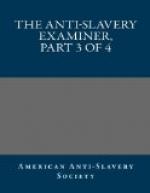“The Rev, Mr. C. a Methodist minister, held as his slave a negro man, who was a member of his own church. The slave was considered a very pious man, had the confidence of his master, and all who knew him, and if I recollect right, he sometimes attempted to preach. Just before the Nat Turner insurrection, in Southampton county, Virginia, by which the whole south was thrown into a panic, then worthy slave obtained permission to visit his relatives, who resided either in Southampton, or the county adjoining. This was the only instance that ever came to my knowledge, of a slave being permitted to go so far to visit his relatives. He went and returned according to agreement. A few weeks after his return, the insurrection took place, and the whole country was deeply agitated. Suspicion soon fixed on this slave. Nat Turner was a Baptist minister, and the south became exceedingly jealous of all negro preachers. It seemed as if the whole community were impressed with the belief that he knew all about it; that he and Nat Turner had concocted an extensive insurrection; and so confident were they in this belief, that they took the poor slave, tried him, and hung him. It was all done in a few days. He protested his innocence to the last. After the excitement was over, many were ready to acknowledge that they believed him innocent. He was hung upon suspicion!
“In R—— county, North Carolina, lived a Mr. B. who had the name of being a cruel master. Three or four winters since, his slaves were engaged in clearing a piece of new land. He had a negro girl, about 14 years old, whom he had severely whipped a few days before, for not performing her task. She again failed. The hands left the field for home; she went with them a part of the way, and fell behind; but the negroes thought she would soon be along; the evening passed away, and she did not come. They finally concluded that she had gone back to the new ground, to lie by the log heaps that were on fire. But they were mistaken: she had sat down by the foot of a large pine. She was thinly clad—the night was cold and rainy. In the morning the poor girl was found, but she was speechless and died in a short time.
“One of my neighbors sold to a speculator a negro boy, about 14 years old. It was more than his poor mother could bear. Her reason fled, and she became a perfect maniac, and had to be kept in close confinement. She would occasionally get out and run off to the neighbors. On one of these occasions she came to my house. She was indeed a pitiable object. With tears rolling down her checks, and her frame shaking with agony, she would cry out, ’don’t you hear him—they are whipping him now, and he is calling for me!’ This neighbor of mine, who tore the boy away from his poor mother, and thus broke her heart, was a member of the Presbyterian church.
“Mr. S——, of Marion District, South Carolina, informed me that a boy was killed by the overseer on Mr. P——’s plantation. The boy was engaged in driving the horses in a cotton gin. The driver generally sits on the end of the sweep. Not driving to suit the overseer, he knocked him off with the butt of his whip. His skull was fractured. He died in a short time.




